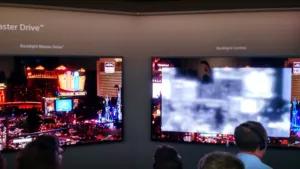In a backroom at I/ITSEC 2016, Sony was showing a comparison of its native 4K projector vs. an e-shift model from JVC. The e-Shift model use 1080p imagers and creates two sub-fields at a 120 Hz rate that are offset in the diagonal direction by a ½ pixel (using an optical shifting element). Sony wanted to show the benefits of its native resolution 4K panel vs. an e-Shift projector.
Sony did a similar comparison at CEDIA 2016 (Sony 4K Projector Shoot-Out Result Unclear), but did not do such a great job in convincing me of the benefits of native over e-shifted projectors.
The story was different at I/ITSEC. Why – because at CEDIA, the content was test patterns and video that could only be viewed from several feet away. At I/ITSEC, the content was test patterns and computer generated simulation content and we were able to get very close to the image.
The set up consisted of the two projectors stacked one on top of the other with a simple mechanical shutter to block the light from one or the other projector. Content was fed from a media player to both projectors and was UHD resolution.
However, one of the first things we noticed was a shadow in the test patterns that looked like a blue underscore on the test and patterns. This was evident on both projectors so was likely in the content (strangely, Sony did not notice this until we pointed it out). We theorized that the pattern generator may have been generating this artifact in the conversion to video (perhaps in a 4:2:0 format) or the artifact was a result of some chroma issue in the splitter.
The test pattern consisted of a series of 1, 2 and 3-pixel wide patterns surrounded by a large circle. The Sony projector did a very good job of reproducing these patterns well, but did not create smooth lines in the circle pattern. The JVC projector did ok with the 3-pixel wide patterns, worse with the 2-pixel wide and could not reproduce the single pixel patterns, as expected. It also showed strange artifacts on the circle pattern.
But the CG content was most telling. What was shown was native 4K IG content of a complex city scene with lots of detail in building and trees. This was quite sharp with the Sony projector and noticeably soft with the JVC.
The Sony exhibited some aliasing on diagonal lines and fine patterns, but the JVC looked much worse here. The kind of flashing aliasing artifacts seen can be very noticeable and one of the key objections from end users.
If Sony had then shown a 4K video clip, we would probably have been hard pressed to have seen a big difference, except perhaps in some overall sharpness. That’s why the I/ITSEC demo was better at showcasing the difference than the CEDIA demo. – CC

